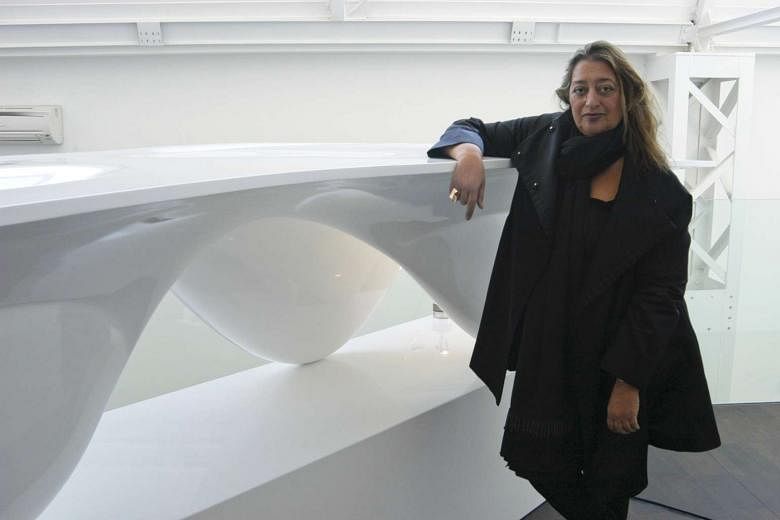NEW YORK • The death of Zaha Hadid at 65 last Thursday has reverberated through quarters of the architecture world from Baghdad, where she was born, to New York, London and Guangzhou where she built.
But the sense of loss, mounting online, has been most pronounced among female architects, who saw her as a rare beacon of hope for their own success in a male- dominated field and a barometer of its continuing sexism.
"As a female architect, I am in shock and distressed that another brilliant creative mind has passed away, especially a woman on a par with the best male architects in the world," Ms Gisela Schmidt, an architect in Atlanta, wrote on Facebook. "She was a strong woman in a profession that" silences them, she added. "What a loss for us."
In The Guardian, Eva Jiricna, a former president of the Architectural Association in London and a close friend of Hadid's, said: "I don't think any man could actually compete with her. If we can eliminate the practice of talking about female architects, it would be the greatest tribute we could give her."
She added that even after advances for women in recent years, it remained difficult for a woman than for a man to get a job in architecture and to be paid the same.
Mr Abdullah Mahmoud, an architect in Damascus, Syria, who posted a tribute to Hadid on Facebook, said that in his classes at Damascus University, from which he graduated last year, about 70 per cent of the students were women - an indicator of how the profession's balance is shifting - and that Hadid's influence was hard to overstate.
"For young architects here, especially the female ones, she was like a great princess," he said. "For us, it was like: If Zaha Hadid could go to London and be a great architect and build for the Olympics and in China and everywhere, why can't we do that? That was very strong for the women I studied with."
Hadid was the first woman to win the Pritzker Prize, architecture's top honour, in 2004, a quarter- century after the prize's founding.
Since that milepost, the percentage of female architects in the United States has barely grown, increasing to 25.7 per cent from 24 per cent, according the Bureau of Labor Statistics.
Architect Richard Meier recalled how architects used to gather for dinner at the Century Club in New York, including Philip Johnson, Michael Graves and Peter Eisenman. "Zaha was the first woman, as far as I can remember, to attend one," he said. "She had a sense of herself that she could fit in wherever she wanted. She knew that what she did was highly respected."
Initially, Hadid seemed to resist the idea of serving as a role model because of her gender.
"She's a woman architect who never wanted to be called a woman architect - she was just an architect and one of the best ones," said Dr Amale Andraos, dean of Columbia University's architecture school.
"But she broke new ground by being a woman, by not being Western, by being educated all over the world - there is so much she enabled."
Over time, Hadid came to recognise her importance as a symbol. In the book Where Are The Women Architects?, to be published this month by Princeton University Press, Dr Despina Stratigakos, interim chairman of the University at Buffalo's architecture department, recounts Hadid's comments after winning the Architects' Journal's inaugural Jane Drew Prize for "her outstanding contribution to the status of women in architecture" in 2012.
"I used to not like being called a woman architect: I'm an architect, not just a woman architect," she said after winning the award, in an interview with CNN. "Guys used to tap me on the head and say, 'You are okay for a girl.' But I see the incredible amount of need from other women for reassurance that it could be done, so I don't mind that."
Despite her efforts over the years to be judged on the merits of her work, the news media often included discussion of her physical appearance or manner, rather than her professional performance.
Over the years, Hadid continued to be criticised for headstrong behaviour that her friends say would have gone unnoticed in a man.
Architect Thom Mayne said: "Every body knows her as a diva and as a tough woman. She's tough because she's in a profession that takes toughness to get through it. She has this great sense of humour and is caring. Funny, incredibly loyal. She was a sweetheart. And it's not the part most of the world sees."
Ms Tegan Bukowski, a former student of Hadid's at the Yale School of Architecture, who now works in the London office of Hadid's practice, said the office was rare in the profession, not only because it was nearly equally split between men and women.
"Zaha herself was a role model, but she also created role models in the company by making sure that women thrived," she said. "She never held down men, but it was just about your work and talent.
"And it makes me so sad to think about her being gone because I think, who can I look up to like that now?"
NEW YORK TIMES

